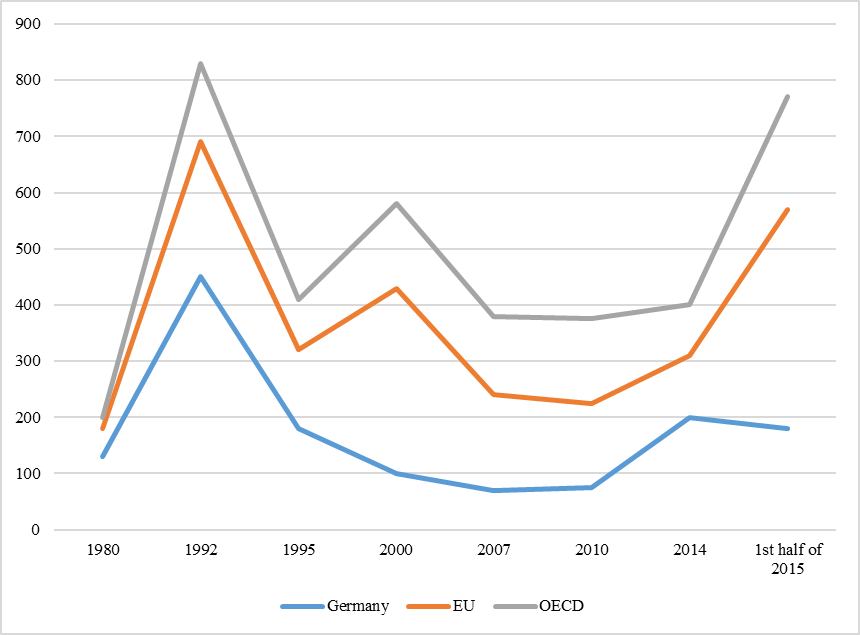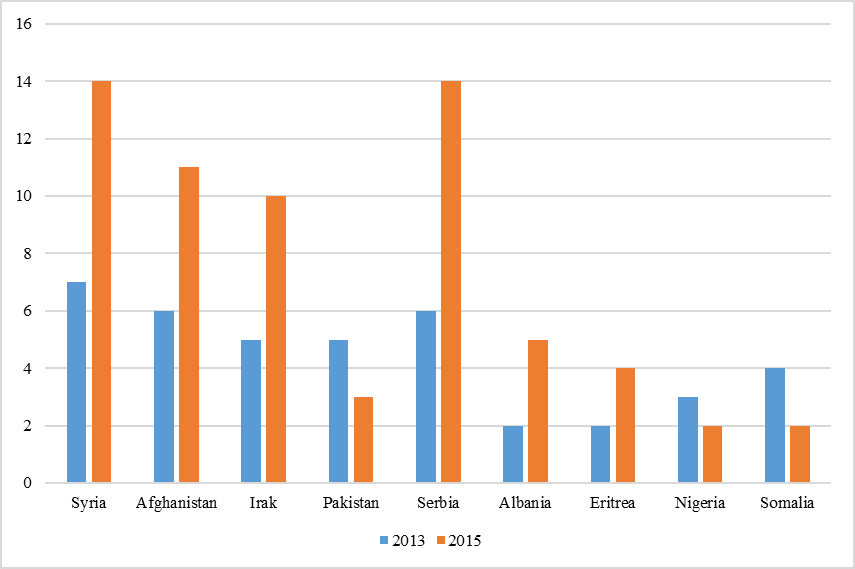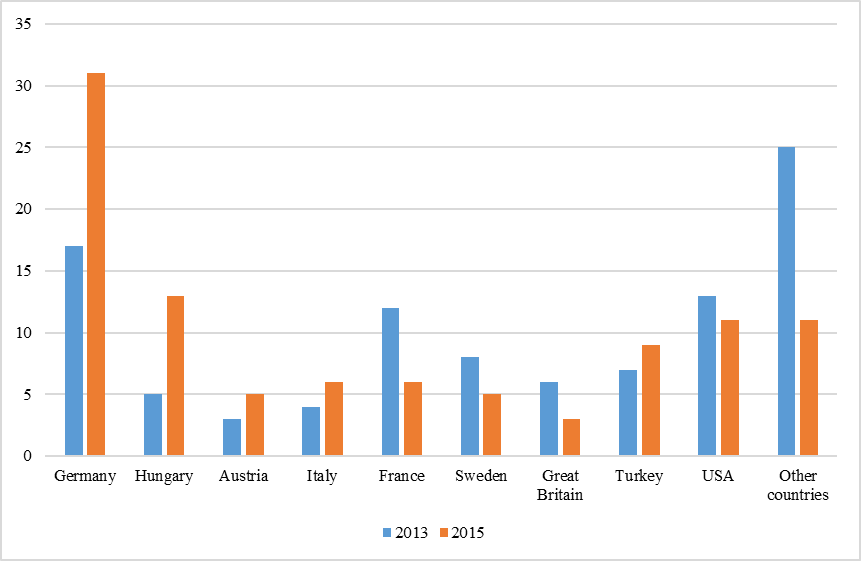Abstract
This article gives the theoretical basis and defines the developed approaches to viewing migration as an inevitable social process in national economy. It considers the main trends in developing migration processes in member states of the Organisation for Economic Co-operation and Development as well as social and economic consequences for developed countries in conditions of common economic and legal space. It shows the specificities of supranational governance practices, cooperation within the framework of the Organisation for Economic Co-operation and Development which has a particular impact on the migration policy. The governments of the European Union member-states pay great attention to the questions of refugee reception, legalization and adaptation of migrant workers, creating special programmes, organizing free language courses, pursuing the policy of human rights protection with regard to migrants of both legal and illegal status. The authors consider the lack of cultural assimilation as one of the main reasons for the failure of multiculturalism in Europe.
Keywords: Migration processlabour forcemigration streamsgovernment regulation policy
Introduction
At the beginning of the XXI century, regulation problems of migration have gone beyond the demographic policy of individual states and now demand new comprehensive and unconventional solutions, joint efforts of national governments and public organisations. The spectrum of migration issues is constantly broadening today. The reason for that is the complexity and multifacetedness of this phenomenon, especially its close connection with human rights and globalization. Additionally, the implications of migration can be seen in various spheres such as social, economic, political, cultural, psychological and etc. Moreover, they could be both positive and negative and, thus, become the source of conflicts (Bilan, 2012; Trifonov et al., 2014). Therefore, migration, its manifestations and influence on the economies of different states is a topical issue for research.
At present, there is quite a wide theoretical base which studies the impact of migration on economic growth of host countries. Three main foreign scientific schools explore migration as: means of capital accumulation (Pietro Reichlin and Aldo Rustichini (1998)), means of human capital accumulation (Uwe Walz (1996), Nadeem U Haque and Se-Jik Kim (1995)) and innovation and technologies acquisition (Per Lundborg, Paul S. Segerstrom (1998, 2000) and Lucas Bretschger (2001)). Scholars Stephen Drinkwater, Paul Levine, Emanuela Lotti and Joseph Pearlman (2002) study various models which consider migration as one of the three engines of economic growth of a country. Taking into account the scale effect evaluation in economy of a host country, the moderate positive influence of migration on GDP per capita was pointed out in the research of Jacques Poot, Ganesh Nana and Bryan Philpott (1988). Thus, by the example of New Zealand, it was determined that an influx of 15 thousand people increases GDP per capita of a host country by 0.2% a year, and GPD per one worker by 0.15% per year. George J. Borjas (1995), the US researcher, assessed economic profit from migration as 0.1% of GDP whereas scientists Robert J. Barro and Xavier I. Sala-i-Martin supposed it to be around 1.1% of GDP of a host country.
Problem statement
Taking into consideration globalisation, strengthening of interstate cooperation and transformational economy, migration regulation policy in particular countries is confronting new challenges of continuously changing environment; and, consequently, today governmental migration policy is impossible without its coordination and collaboration with international organisations and supranational bodies. Given the uniqueness of phenomenon, migration state policy exploration within the framework of OECD member states is gaining more and more topicality.
Research methods and findings on free movement migration
The main feature of state regulation of migration in OECD countries is that they co-exist in a common economic and legal space. The specificity of supranational governance and cooperation practices has a particular impact on migration policy.
The constant influx of foreigners into OECD countries was observed approximately 50 years ago during the post-war period, which was characterised as the beginning of economic growth in Western Europe and Japan. The scale of migration has experienced considerable fluctuations; however, up to the present moment, the constant increase has been monitored (Tashchiyan et al., 2015). In 2013, migration streams within OECD appeared to be three times more intense than in 2000. The immigration peak happened in 2007; after that, two years of decline in the number of newcomers were witnessed (OECD Multilingual Summaries, 2014; Lizunkov et al., 2015).
Revitalization of permanent migration happens mainly due to the growth of free movement, which increased by 10% in 2012. Within the OECD borders, the major part of free movement migration takes place on the territory of the European Union. In 2012, such movement in Europe reached the level that could be compared with constant legal migration from non-European countries. Germany was the main destination hosting almost one third of free movement migrants.

According to the Organisation for Economic Co-operation and Development data, most people seeking refuge (and refugee status) in Europe usually cross borders illegally. 280,000 of such illegitimate entries were registered in 2014, whereas during the first 8 months of 2015, there were 500 thousand crossings. The influx of a similar intensity was only observed in the time of the World War II.
As stated in the OECD report “International Migration Outlook 2015”, the number of children having arrived in the EU without their parents (or foster carers) in 2014 made up 24,000, i.e. 4% of the whole number of refugees. Judging by local investigative information, this index will quite probably rise both in its absolute and relative value (OECD Multilingual Summaries, 2015). The report emphasises that children travelling alone experience a wide range of troubles, even after they have crossed borders of a safe country. Besides that, the entry of large number of refugee children poses a great challenge for any host country since the government should provide them with accommodation, healthcare and education (Nesteruk, & Momot, 2014; Suzdalova, & Kvashnina, 2015). Older teenagers as the most numerous group in this category of refugees suffer more than others because government support often lasts only 1-2 years for them; after that adolescents are thrown out of the healthcare and education systems before they have managed to acquire the necessary skills and knowledge about their new country of residence (Lizunkov et al., 2016).

In 2015, only 14% of refugees arrived in the EU from Syria. In the course of the year, the number was increasing; however, immigrants from the countries that were selected for a new resettlement programme of the European Commission (such as Syria, Iraq and Eritrea) comprise only about one fourth of people who applied for the refugee status in the first half on the year (Worker migration or job creation?, 2016). According to economic forecasts this figure is going to grow in 2016-2017.

Some countries accept plenty of immigrants and help them settle, whereas others hardly notice this unfolding crisis; as a consequence, the burden other countries carry is increasing. In 2013, 17% of all refugees having come to OECD member states settled in Germany, which was already more than in any other country. By 2015, this figure had grown considerably, namely to 31%. And it is going to build up further: official forecasts report that in the nearest future more than one million people will enter the country (Shabashev et al., 2014). However, at the same time the allotment of the United Kingdom with regard to accepted refugees fell from 6% in 2013 to 3% in 2015.
The problem of global migration processes in the modern world has gained special importance for many countries that are actively accepting migrants. One of the states which are most "overloaded" with migrants in Europe is Italy. That is caused by its geographical and geopolitical position which provides an opportunity for constant migration flows and transit migration from the countries of Africa, Eastern Europe, East and South-east Asia and the Middle East. The experience of Italy as a refugee-hosting country is similar to the experience of other countries of Southern Europe: Greece and Spain, which constantly resist the flows of illegal migrants and have to toughen the policy of sea borders control and modes of entry. However, for these countries, as well as for many other European states, migration itself has a number of positive factors, including replacement of jobs in labour market, increase of birth rate in conditions of aging of local population.
In this regard, particular interest is attracted by such model of policy of managing cultural diversity (which is a consequence of migration flows strengthening) as multiculturalism, which implies integration of various ethnic and racial groups into one homogeneous community and simultaneous preservation (together with official support) of their cultural identity and originality. The governments of the European Union member-states pay great attention to the questions of legalization and adaptation of migrant workers, creating special programmes, organizing free language courses, pursuing the policy of human rights protection with regard to migrants of both legal and illegal status. However, in practice, implementation of ideas of multiculturalism has revealed that it is impossible to combine general values of society with preservation of cultural autonomy of communities.
EU countries undertake legislative measures to regulate migration, to legalize migrants and organize refugee reception. Migration policy of the EU is not limited only to prohibitive measures and toughening of control of entry. Its advantages include mobility and adequacy in relation to the constantly changing situation. Nevertheless, the problem of illegal migration persists. Moreover, it is urgent for the whole European society. Immigration is considered as one of the most acute challenges to stability and security of these countries. However, politicians still have not been able to develop a joint effective complex of measures to fight against illegal migration. Thus, according to the International Organization for Migration more than 1700 people have drowned (trying to get to the territory of EU countries) since the beginning of 2015, near the coasts of Africa and Europe. Italy, which is concerned about this problem, founded Mare Nostrum programme in 2013, which was carried out by Italian Naval Forces. During a year of its existence 900 employees could save more than 170 thousand people. In 2014, it was replaced by a more economical mission, namely, operation Triton of the European Border and Coast Guard Agency “Fronteks”. While Italian Coast Guard is engaged in rescue of the drowning people, refugees are brought to ports: since the beginning of the year more than 20 thousand migrants have already moved to the territory of Europe.
The problem of entry and transit to Europe through Italy is being aggravated by a threat from the Islamic State, whose rebels and recruiters make their way to European cities disguised as migrants. At the beginning of 2015 the European Union made the decision to begin a military operation in the Mediterranean Sea against human-traffickers and people-smugglers. At the same time, at the 5th emergency summit in Brussels in April, 2015, leaders of the European Union countries decided to triple financing of operations that rescue migrants in the Mediterranean Sea with a view to efficiently solve the problem of mass death of refugees. The EU intends to consider the possibility of destroying vessels that are used for transportation of illegal migrants and to try to prevent penetration of migrants into Libya, to optimize the process of getting visas and refuge, as well as to take more effective measures to return the migrants (who have not been granted asylum or visas) to the country from which they arrived to Europe.
The main reasons for the failure of multiculturalism in Europe are the lack of cultural assimilation; the increase in the inflow of migrants, whose generations have already grown up in Europe, and who stand for recognition and empowering of their culture and religion, join radical Islamic organizations; deсhristianization of Europe and inactivity of European culture amid strengthening migration.
Thus, the problems of multicultural society are being exacerbated by globalization, which leads to new emerging conflicts.
Conclusion
Several OECD members have revised and revamped their migration legislation for the last years, responding to ever changing migration schemes and political environment. Major changes have been directed at strengthening limitations:
- demand for highly-qualified workers still exists but these countries select them more thoroughly;
- countries look for investors and entrepreneurs, however they observe their activities more closely;
- particular procedures of family immigration (family reunification) have been simplified, though the mainstream trend is still aimed at restriction;
- new measures have been taken in respond to the humanitarian crisis in the Mediterranean region;
- new measures have been introduced to enhance customs control, encourage voluntary return to native countries and to fight illegal employment of immigrants (Ustubici A., Irdam, 2012).
It is highly important to solve the problem of a cultural component of migration processes as communication of carriers of various cultures which determine tolerance level in society. Manifestations of inter-ethnic problems emphasize the necessity of transition from the policy of migration processes regulation to the policy of ethno-cultural regulation.
By and large, national governmental mechanisms should be activated in order to eliminate negative social and economic implications of international labour migration which would not only lead to even balanced regional development but also help overcome economic asymmetry. Thus, the efficient regulation of migration processes consists in continuous and consistent implementation of correctly selected measures which correspond to the social, economic and demographic interests of OECD member states, taking into account economic and public objectives and aims.
Acknowledgements
We are grateful to the University of Canterbury, the Institute of Philology and Intercultural Communication at Volgograd State University, the Department of Economics and Automated Control Systems at Yurga Institute of Technology (branch) of Tomsk Polytechnic University, Institute of Public Administration and Entrepreneurship at Ural Federal University named after the first President of Russia B. N. Yeltsin for the research opportunity and assistance.
References
- Bilan, Y. (2012). Specificity of Border Labour Migration. Transformations in Business & Economics, 11, 82–97.
- Lizunkov, V. G., Marchuk, V. I. & Podzorova, E. A. (2015). Identification of Criteria, Features and Levels of Economic and Managerial Competencies Development for Bachelors in Mechanical Engineering. Procedia - Social and Behavioral Sciences, 2015, Vol. 206, 388-393.
- Lizunkov, V. G., Minin, M. G., Malushko, E. Y. & Medvedev, V. E. (2016). Developing economic and managerial competencies of bachelors in mechanical engineering. SHS Web of Conferences, № 28, 01063, URL: http://www.shs-conferences.org/articles/shsconf/abs/2016/06/shsconf_rptss2016_01063/shsconf_rptss2016_01063.html (date of access: 18.06.2016).
- Nesteruk, D.N. & Momot, M.V. (2014). Information Technology of Estimation and Forecasting Innovative Activity Based on Distributed Data Input. Applied Mechanics and Materials, Vol. 682, 579-585.
- OECD Multilingual Summaries. International Migration Outlook 2014. Summary in Russian. (2014). http://www.
- OECD Multilingual Summaries. International Migration Outlook 2015. Summary in Russian. (2015). http://www.
- Shabashev, V.A., Trifonov, V.A. & Verzhitsky, D.G. (2014). The problems of developing the ecological market of the region. Applied Mechanics and Materials, Vol. 682, 591-595
- Suzdalova, M.A. & Kvashnina, D.A. (2015). Potential of IT culture as a means of development of high-tech educational IT environment. BULLETIN, Buryat State University, 14A, 190-192.
- Tashchiyan, G.O., Sushko, A.V. & Grichin, S.V. (2015). Microsoft Business Solutions-Axapta as a basis for automated monitoring of high technology products competitiveness. IOP Conference Series: Materials Science and Engineering, Vol. 91, Article number 012065, 1-6.
- Trifonov, V.A., Grichin, S.V. & Kovaleva, M.A. (2014). Price differentiation as economic and mathematical model of increasing the competitive pover of a company. Applied Mechanics and Materials, Vol. 682, 606-612.
- Ustubici, A., Irdam (2012). The Impact of Remittances on Human Development: a Quantitative Analysis and Policy Implications. Economics and Sociology, Vol. 5, 1, 74–95.
- Worker migration or job creation? Persistent shocks and regional recoveries (2016). Journal of Urban Economics, Volume 96, Issue null, 1-16.
Copyright information

This work is licensed under a Creative Commons Attribution-NonCommercial-NoDerivatives 4.0 International License.
About this article
Publication Date
20 July 2017
Article Doi
eBook ISBN
978-1-80296-025-9
Publisher
Future Academy
Volume
26
Print ISBN (optional)
Edition Number
1st Edition
Pages
1-1055
Subjects
Business, public relations, innovation, competition
Cite this article as:
Davis, N., Ergunova, O., Lizunkov, V., & Malushko, E. (2017). Phenomenon of Migration and Its Manifestations in the Modern World. In K. Anna Yurevna, A. Igor Borisovich, W. Martin de Jong, & M. Nikita Vladimirovich (Eds.), Responsible Research and Innovation, vol 26. European Proceedings of Social and Behavioural Sciences (pp. 550-556). Future Academy. https://doi.org/10.15405/epsbs.2017.07.02.70

